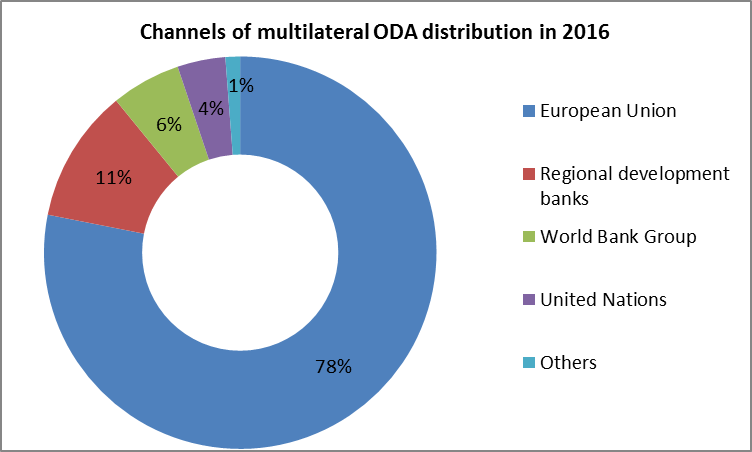Polish Aid 2016 in numbers
In 2016 Poland earmarked PLN 2,615 million for official development assistance (ODA), including PLN 2,027 million for multilateral cooperation, which accounted for 78% of all funds. Poland also set aside PLN 588 million for bilateral assistance (22% of all funds). Bilateral assistance totalled PLN 383 million, not including cash flows under loan agreements. Development cooperation funds made up 0.15% of the Polish Gross National Income (GNI).
Geographic and thematic priorities
Polish development cooperation 2016 was based on a new Multiannual Development Cooperation Programme 2016-2020 which defines its geographic and thematic priorities.
Geographical areas were divided into two groups. The first one covers four Eastern Partnership countries: Belarus, Georgia, Moldova, and Ukraine, where Polish aid focuses on supporting good governance, human capital, entrepreneurship and the private sector, as well as agriculture and rural development.
The second group covers selected countries in Africa, Asia, and the Middle East. It includes six countries: Ethiopia, Kenya, Myanmar, Palestine, Senegal, and Tanzania, most of them characterized by a high level of poverty. In these countries, assistance is directed at human capital, environmental protection, entrepreneurship and the private sector, agriculture and rural development.
Apart from the above-mentioned priority countries, Poland supports also other countries which are included in the list of developing countries in line with OECD/DAC guidelines (DAC List of ODA Recipients).
Bilateral ODA
In 2016, key recipients of Polish bilateral assistance were: Ethiopia, Ukraine, Tanzania, Belarus, Turkey, Syria, Kenya, Angola, Moldova, and Georgia. A detailed list of major recipients of Polish ODA in 2016 below.
|
No |
recipient country of Polish ODA |
PLN million
|
|
1. |
Ethiopia* |
166.80 |
|
2. |
Ukraine |
95.03 |
|
3. |
Tanzania* |
90.32 |
|
4. |
Belarus |
75.65 |
|
5. |
Turkey |
71.49 |
|
6. |
Syria |
37.21 |
|
7. |
Kenya |
34.70 |
|
8. |
Angola* |
17.07 |
|
9. |
Moldova |
8.45 |
|
10. |
Georgia |
7.25 |
|
11. |
Iraq |
6.36 |
|
12. |
Palestine |
4.76 |
|
13. |
Cambodia* |
3.86 |
|
14. |
Kazakhstan |
3.35 |
|
15. |
Kosovo |
2.46 |
|
16. |
Afghanistan |
2.04 |
|
17. |
Senegal |
1.11 |
|
18. |
Mongolia |
1.05 |
|
19. |
Myanmar |
0.79 |
|
20. |
Indonesia |
0.71 |
*Indicated sums include payments within loan agreements for: Angola, Ethiopia, Kenya, and Tanzania and debt relief for Cambodia.
The bulk of bilateral cooperation (PLN 208 million) consisted in credits and debt relief. In 2016, Angola, Ethiopia, Kenya, and Tanzania received payments from loan agreements, and Cambodia had its debt redeemed.
Considerable funds were also earmarked for humanitarian aid (PLN 124 million) which was addressed mostly to the people affected by the Middle East crisis, including Syrian refugees.
Another important part of Polish ODA was support for education by granting scholarships and financing the costs of education (PLN 117 million).
Organised grant proceedings
In 2016, the MFA’s Department of Development Cooperation organized five open grant proceedings which selected 91 projects for funding totalling PLN 39,926,925, including:
- “Polish development assistance 2016” call for proposals – PLN 26,152,426 (53 projects)
- “Polish Aid volunteering programme 2016” call for proposals – PLN 776,521 (14 projects)
- “Global education 2016” call for proposals – PLN 1,835,035 (12 projects)
- “Humanitarian aid in the Middle East and Ukraine 2016” call for proposals – PLN 7,235,317 (7 projects)
- “Humanitarian aid in the Middle East 2016” call for proposals – PLN 3,927,626 (5 projects)
Multilateral ODA
The largest part of Polish multilateral development assistance contributed to European Union funds allocated to external development assistance. In 2016, Polish participation in these funds reached PLN 1.58 billion. It included part of the EU budget contribution which was allocated to development goals (PLN 1.3 billion[1]) and a contribution (PLN 284 million[2]) to the European Development Fund (EDF) which is the EU’s key non-budgetary instrument to finance cooperation with African, Caribbean and Pacific (ACP) countries and Overseas Countries and Territories (OCTs).
Poland earmarked PLN 80 million for entities working within the United Nations System, and PLN 116 million for entities operating within the World Bank group. Funds provided to regional development banks amounted to PLN 223 million (and were mostly transferred to the newly established Asian Infrastructure Investment Bank, AIIB).
[1] Poland makes one contribution to the EU budget without differentiating into specific programmes, funds, or instruments. Polish participation in the European Union’s official development assistance is calculated in the following way: knowing the size of the EU budget and the value of Polish contribution it is possible to calculate what percentage of the EU budget consists in Polish contribution. Assuming that Polish participation in EU official development assistance is the same as its participation in all EU budget, it can be calculated based on data from the EU budget execution. Estimated data from budget execution are updated according to successive European Commission’s reports, so they can be subject to substantive changes.
[2] The value of Member States’ contributions to the European Development Fund is defined each time by the European Commission based on its estimate of financial needs connected with actions envisaged under a given EDF. Unused funding from a given EDF is not reimbursed to the payers. Instead, it is transferred to the next EDF.
